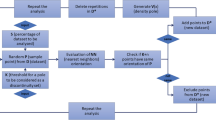Summary
The surface approximation and contour mapping (SACM) package was used to prepare automatic contour plots of geological surfaces in South Essex from borehole data. A manual plot of the London Clay surface prepared by a geologist showed marked local differences from plots produced by SACM and other commercially available packages. The distribution of data appeared to be the main factor responsible for the different interpretations, and in order to test the effectiveness of various data point distributions, an idealised London Clay surface, 9 km×6 km was taken as a model. An initial SACM plot from 93 data points distributed uniformly over the area as an 800 m grid contained fairly large errors when compared with the model, particularly in two localities of relatively, short wavelength variations. Significant reduction in both standard deviation and sum of errors squared was achieved by the addition of 60 data points at 400 m spacing in these two localities. The results are consistent with a data point distribution corresponding to approximately half the local wavelength of variation and give a guide to best borehole positioning in site investigations.
Résumé
Le système d'approximation de la surface et de cartographie par courbes (SACM) a été utilisé pour préparer des levés en courbes automatiques de surfaces géologiques dans le South Essex, d'après les données fournies par des sondages. Un levé manuel du toit de l'Argile de Londres, préparé par un géologue, présentait de nettes différences locales avec les levés obtenus par le SACM et par d'autres systèmes disponibles dans le commerce. Il apparut que le principal facteur responsable des différentes interprétations était le répartition des points de mesures, et l'on choisit un quadrilatère fictif d'Argile de Londres, de 9 km×6 km, comme aire expérimentale pour tester l'influence de différentes répartitions des points de mesures.
Un premier levé effectué par le SACM à partir de 93 points de mesures répartis uniformément, c'est-à-dire formant un réseau de 800 m d'équidistance, présentait des erreurs assez importantes par rapport au modèle, en particulier en deux localités où les variations de longueur d'onde sont relativement courtes. En ajoutant 60 points de mesure, formant un réseau de 400 m d'équidistance en ces deux localités, on obtint une nette réduction de la déviation standard et de la somme des carrés des erreurs. Les résultats correspondent à une répartition des points de mesure à une équidistance d'environ la moitié de la longueur d'onde de la variation. Ils permettent de guider la mise en place optimale des sondages.
Similar content being viewed by others
References
BLACKMAN R. B.—TUKEY J. W. (1959): The measurement of power spectra. Dover Publications, Inc., New York, 190 pp.
CRATCHLEY C. R. (1977): Engineering Geology of South Essex, in Institution of Civil Engineers, Surface Modelling by Computer, Paper 6, 43–49, and Discussion 92–99, I. C. E., London 1977.
CRATCHLEY C. R.—CONWAY B. W.—NORTHMORE K.J. (in press): South Essex geological and geotechnical survey, IAEG Symposium on engineering geological mapping, Newcastle upon Tyne, September 1979.
DAVIS J. S. (1973): Statistics and data analysis in geology. Wiley International Edition John Wiley & Sons Inc., 550 pp.
I. G. S. (1975/77): South Essex geological and geotechnical survey. Report prepared for the Department of the Environment in 12 parts.
WALTERS R. F. (1969): Contouring by machine: a user's guide. American Assoc. of Petroleum Geologists Bulletin, V. 53, No. 11, 2324–2340.
Author information
Authors and Affiliations
Rights and permissions
About this article
Cite this article
Coe, L., Cratchley, C.R. The influence of data point distribution on automatic contouring. Bulletin of the International Association of Engineering Geology 19, 284–290 (1979). https://doi.org/10.1007/BF02600490
Published:
Issue Date:
DOI: https://doi.org/10.1007/BF02600490




